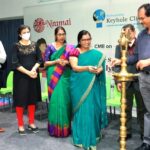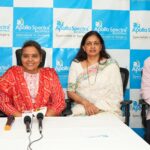Breast cancer is ranked as the most common cancer among Indian females. One in every five women in India carry anomalies in breasts, Many women tend to avoid breast screening due to psycho-social barriers.
One in every five healthy women in India carry anomalies in their breasts that, though usually harmless, carry the potential of developing into life-threatening cancers. The findings are based on data of around 200 healthy women who underwent breast-cancer screening in the last few months at NURA, a collaboration between Fujifilm Healthcare and Dr Kutty’s Healthcare offering AI-enabled imaging and expert healthcare at Bengaluru.


According to Dr.Tausif Ahmed Thangalvadi, Medical Director, NURA: “The figure of breast anomalies for Indian women is double the global average of one in ten. It is important that these anomalies are detected in time by advanced diagnostic equipment during preventive check-ups and further follow-ups conducted to gauge the actual risk to the woman.Yet, many women tend to avoid breast screening due to psycho-social barriers, including embarrassment at discussing the issue of breast cancer, fear of pain while undergoing a mammogram and anxiety at the possibility of finding something adverse. Many assume that breast cancer screening is needed only for older women.”
Breast cancer is the most common cancer
Breast cancer is ranked as the most common cancer among Indian females, with an incidence of 25.8 and mortality of 12.7 per 100,000 women. The city wise incidence per 100,000 women varies from 41 in Delhi to 37.9 in Chennai and 34.4 in Bengaluru. Over the last 30 years, Bengaluru has seen the highest rate of increase in the incidence of breast cancer at 2.84%, compared to 1.44% for Delhi, 1.42% for Mumbai and 2.44% for Chennai[1].
Said Dr.Tausif Ahmed Thangalvadi:“It is recommended that women above 45 years should be screened with mammography once a year. Women between 40 to 44 years should also do the same as a matter of choice. Younger women can do the screening if they have a family history or if they find any suspicious lumps in the breast. As a choice, younger women can get a mammogram done once every 2 years.”
Death rate due to breast cancer increases drastically if it is not detected in time. The mortality-to-incidence ratio in rural areas for breast cancer is 66% due to late detection, compared to only 8% in urban areas where people are more aware and the disease is detected early. Timely detection is important because while the five-year survival rate of breast cancer patients is 100% in Stage 1 of the disease, it reduces to just 22% in stage 4. The risk for breast cancer increases with age. Most cases of breast cancer are diagnosed after age 50. Other risk factors that one can change with appropriate behaviour include not being physically active, being overweight or obese after menopause, taking hormones or certain birth control pills, having first pregnancy after the age of 30, not breastfeeding and drinking alcohol.
Breast-cancer screening:
Mammogram, an X-ray of the breast, remains the gold standard for breast cancer screening. However, it is generally a painful procedure as the breast is compressed between two plates for about 15 to 20 minutes. Other tests done for breast cancer screening include a breast exam conducted by the doctor, breast ultrasound, breast MRI and biopsy which is the only definitive way to make a diagnosis of breast cancer.
The gold standard for diagnosing breast cancer is a mammogram, but many women hesitate to take it as it is often painful. At NURA, sweet-fit paddle technology allows women to experience the mammogram with the least amount of pain and help screen for breast cancer.We use 3D tomosynthesis process for mammography. The images are intelligently reconstructed to create a 3D model that allows doctors to make quick and accurate diagnoses. The 3D tomographic images make it easier to identify abnormalities when compared to regular mammography, where the overlapping breast structures make it harder to identify an abnormality.The sophisticated artificial-intelligence software at NURA acts as a strong assisting tool for our doctors to make their interpretation more precise and accurate.
[1]The Asia Pacific Journal of Clinical Oncology, February 2017











